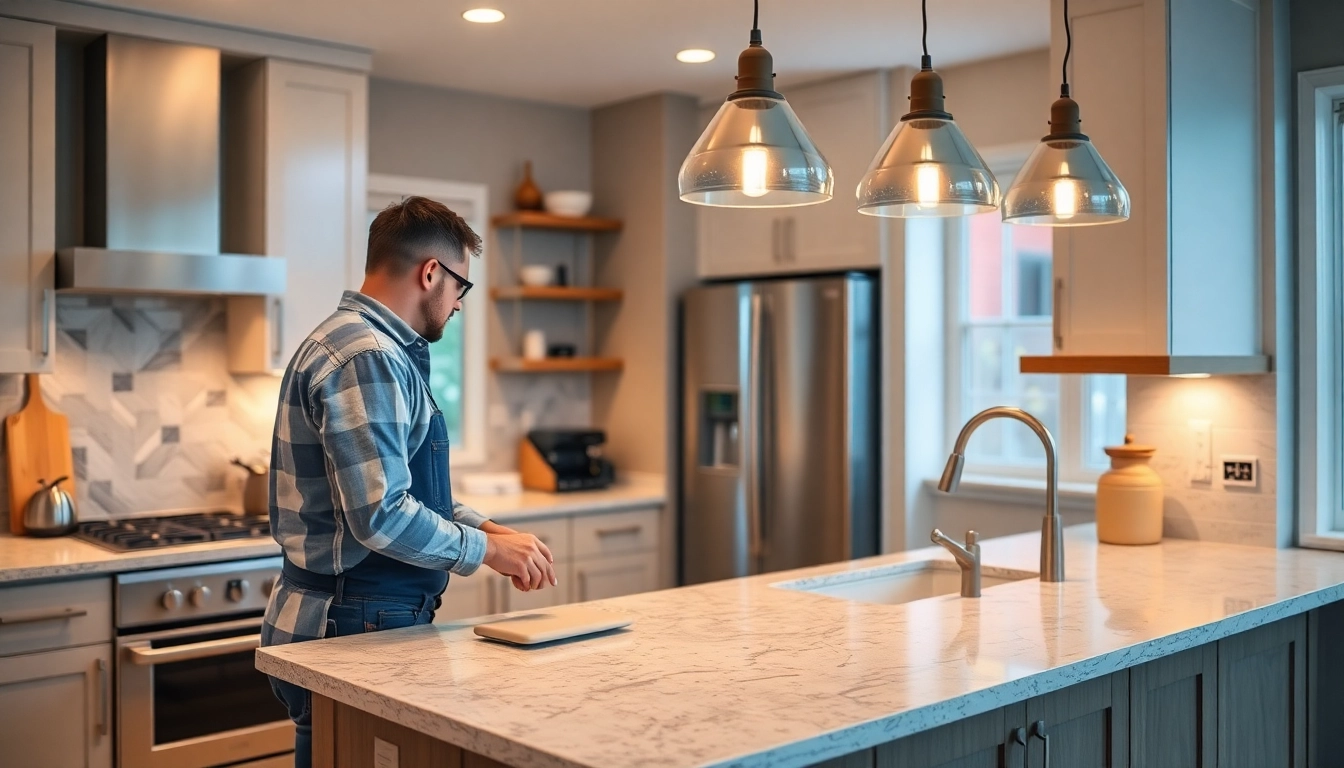
Understanding the Basics of Remodeling
Remodeling is an integral part of maintaining, enhancing, and adding value to a home. Whether you’re aiming for a modern kitchen renovation, a luxurious bathroom upgrade, or an entire home overhaul, understanding the fundamentals of remodeling sets the foundation for a successful project. In the United States, the term Remodeling encompasses a wide array of activities that alter the structure, appearance, and functionality of a property. It’s a strategic investment that not only improves your living environment but can also yield significant financial returns.
In this comprehensive guide, we delve into what remodeling truly entails, how it differs from related concepts like renovation, and outline the key components that contribute to a successful remodeling project. By understanding these principles, homeowners can make informed decisions, avoid pitfalls, and achieve outcomes that match their style, needs, and budget.
What is Remodeling and How Does It Differ from Renovating?
Defining Remodeling
Remodeling involves changing or altering the structure, layout, or style of a home to meet specific goals. According to the Collins Dictionary, remodeling is “the act of changing or altering the structure, style, or form of something.” This can include adding new rooms, removing walls, changing floor plans, or updating systems—such as electrical or plumbing—to improve efficiency and safety.
Unlike simple cosmetic upgrades, remodeling is more extensive and often involves a transformation of the property’s main features. It is a proactive approach aimed at redefining the home’s function and appearance, tailored to accommodate evolving lifestyles or aesthetic preferences.
Renovating vs. Remodeling
Many homeowners confuse renovation with remodeling, but these are distinct processes with different scopes. Renovating primarily focuses on making cosmetic changes—painting walls, replacing fixtures, refinishing surfaces—that enhance the current structure without significant alteration to the layout.
Remodeling, on the other hand, is a structural overhaul. It may involve removing or adding walls, re-routing plumbing or electrical systems, and significantly changing the spatial configuration of the home. Both strategies can increase property value and functionality; however, remodeling typically requires more planning, permits, and investment.
Understanding this difference is crucial for setting realistic expectations and selecting the appropriate approach for your goals. For example, if your main concern is updating the look of a room, renovation suffices. But if you’re looking to reconfigure the entire layout or add square footage, remodeling is necessary.
For detailed insights, visit Rocket Mortgage’s explanation of renovation and remodeling.
Key Components of a Successful Remodeling Project
Clear Project Goals and Vision
Every successful remodeling project begins with well-defined goals. Homeowners should articulate exactly what they want to achieve—be it increased living space, improved aesthetics, enhanced functionality, or energy efficiency. Developing a clear vision ensures that decisions throughout the project align with these objectives.
Creating mood boards, collecting inspiration images, and consulting with design professionals can help refine this vision. Documenting your priorities early on prevents scope creep and keeps the project focused.
Realistic Budget Planning
Budgeting is arguably the most critical element. Accurate cost estimation includes materials, labor, permits, and contingency funds. A common pitfall is underestimating expenses, leading to delays or compromises on quality. Experts recommend allocating at least 10-15% for unforeseen costs.
Using a detailed budget template and consulting with experienced contractors can create a realistic financial plan. Always consider the long-term value—investments in durable, energy-efficient materials often pay off over time.
Design and Material Selection
Design choices impact both aesthetics and functionality. Selecting high-quality, sustainable materials enhances durability and reduces future maintenance costs. Modern trends favor eco-friendly options, smart home integrations, and versatile designs that adapt over time.
Engaging with a professional designer or remodeling contractor can ensure that your selections complement your lifestyle while staying within budget.
Regulatory Compliance and Permits
Familiarity with local building codes and obtaining necessary permits is essential to avoid legal complications and ensure safety. A licensed contractor will typically handle this process, validating that all work adheres to standards and that inspections are passed.
Non-compliance can lead to penalties, delays, or even the need for costly rework, which is why working with reputable professionals is highly advised.
Project Management and Communication
Effective project management ensures timely completion, stays within budget, and upholds quality standards. Regular communication between homeowners, designers, and contractors fosters transparency, addresses issues promptly, and clarifies expectations.
Technology tools such as project management software or detailed timelines help track progress and document decisions. Consistent oversight minimizes miscommunication and keeps the project on track.
Quality Craftsmanship and Materials
Choosing experienced contractors with a proven track record is vital. Superior craftsmanship, attention to detail, and quality materials result in a finished product that lasts longer, functions better, and looks exceptional. Don’t compromise on quality—it’s the foundation of a successful remodel.
Request references, view past projects, and verify licensing and insurance before hiring professionals.
Post-Project Review and Maintenance Planning
After project completion, a thorough walk-through helps ensure all work meets your expectations. Establishing a maintenance plan preserves the integrity of new features and prevents premature issues.
Documentation of warranties and instructions for care can prolong the lifespan of your investment.
Common Remodeling Mistakes to Avoid
Inadequate Planning
Jumping into a remodel without comprehensive planning often results in scope creep, budget overruns, and dissatisfaction. Establishing a detailed design, timeline, and budget from the outset is crucial to minimize surprises.
Ignoring Local Building Codes
Failing to secure permits or comply with regulations can lead to legal consequences, fines, or having to undo work. Always work with licensed professionals who are familiar with local requirements.
Choosing Low-Quality Materials for Cost Saving
It may be tempting to cut costs upfront, but low-quality materials can lead to frequent repairs and replacements. Investing in durable, energy-efficient options often results in long-term savings and increased satisfaction.
Overlooking the Importance of Professional Help
DIY projects may seem cost-effective but often compromise safety and quality. Skilled professionals bring expertise, efficiency, and assurance that work meets standards.
Neglecting Future Flexibility
Designing with future needs in mind ensures that your space remains functional as your lifestyle evolves. Flexible layouts and adaptable features provide longevity to your investment.
Planning Your Remodeling Project
Setting Realistic Goals and Budgeting
Begin by clearly defining what you want to accomplish, whether it’s updating aesthetics, improving functionality, or boosting property value. Use this clarity to establish a feasible budget, considering factors such as scope, material quality, and labor costs.
Research costs in your local area—home prices and construction expenses vary across regions. Consulting industry reports or talking to multiple contractors can help set financial expectations.
Designing for Functionality and Aesthetics
Balance form and function by choosing designs that suit your lifestyle while reflecting personal taste. For example, open-concept layouts increase social space, while smart storage solutions maximize efficiency.
Utilize 3D rendering tools or professional designers to visualize changes before committing, ensuring the final design aligns with your goals.
Selecting the Right Remodeling Contractor
Finding a reputable contractor is paramount. Look for licensed, insured, and experienced professionals with strong reviews and a portfolio of completed projects similar to yours.
Interview multiple candidates, seek references, and establish clear contracts specifying scope, timeline, budget, and warranties. This due diligence mitigates risks and enhances overall satisfaction.
Executing Remodeling Services with Precision
Step-by-Step Remodeling Process
An effective process generally follows these stages:
- Design and Planning: finalize designs, permits, and selections.
- Demolition: clear the old to make way for new.
- Structural Work: framing, foundation, and systemic upgrades.
- Systems Installation: electrical, plumbing, HVAC.
- Interior Finishes: drywall, painting, flooring.
- Final Touches: cabinetry, fixtures, hardware.
Adherence to this sequence ensures efficiency and quality control.
Managing Timelines and Quality Control
Establish a schedule with milestones and conduct regular inspections. Clear communication and detailed documentation prevent misunderstandings. Employ project management tools to track tasks and hold all parties accountable.
Address issues promptly to avoid delays and ensure compliance with safety and quality standards.
Utilizing Sustainable and Innovative Materials
Green building practices are increasingly popular. Use energy-efficient appliances, low-VOC paints, reclaimed wood, and other eco-friendly materials to reduce environmental impact and operating costs.
Innovation—such as smart lighting, automated thermostats, and integrated home systems—adds convenience and future-proofs your investment.
Optimizing Your Home’s Value through Remodeling
Enhancing Curb Appeal and Interior Design
First impressions matter. Updating exterior features like new siding, landscaping, and entryways increases the attractiveness of your property. Inside, modern finishes, neutral color palettes, and thoughtful layouts create inviting spaces.
High-impact areas like kitchens and bathrooms typically offer the greatest return on investment.
Increasing Energy Efficiency and Durability
Energy-efficient appliances, insulation, smart windows, and high-quality roofing reduce utility bills and environmental footprint. Durable materials resist wear and tear, minimizing maintenance costs.
Adding insulation, sealing drafts, and upgrading HVAC systems improve comfort and sustainability.
Measuring Success: ROI and Long-Term Benefits
Return on investment depends on project scope and market conditions. It’s wise to consult real estate professionals to assess how remodeling impacts property value.
Long-term, a well-executed remodel enhances daily living quality, safety, and the home’s appeal—benefits that extend beyond monetary gains.
Latest Trends and Tips in Remodeling
Popular Styles and Modern Features
Current trends favor minimalist designs, open floor plans, natural textures, and neutral color schemes. Emphasis on multifunctional spaces accommodates remote work, wellness areas, and entertainment zones.
Industrial accents, vintage fixtures, and transitional styles seamlessly blend traditional and contemporary elements.
Smart Home Technologies Integration
The integration of smart technology is transforming home living. Automated lighting, security systems, thermostats, and voice-controlled assistants enhance convenience and energy management.
Planning for smart features during renovation ensures seamless integration and future flexibility.
Creative Ideas for Small and Large Spaces
Maximizing space is essential. Use vertical storage, multi-purpose furniture, and clever layout plans in smaller homes. Larger spaces benefit from zoning, accent walls, and statement features that define distinct areas.
Innovative solutions like fold-away beds, hidden cabinets, and outdoor-indoor flow expand usable square footage and versatility.








